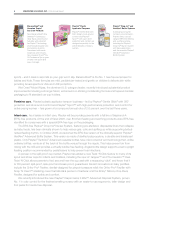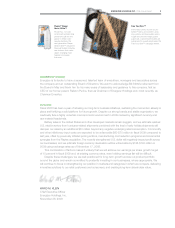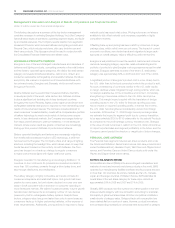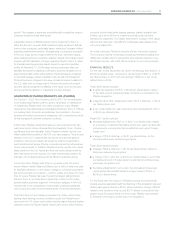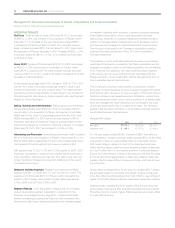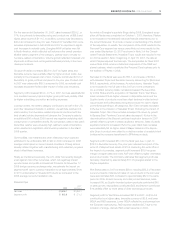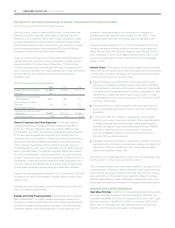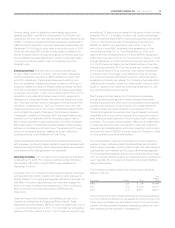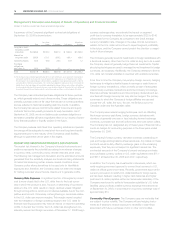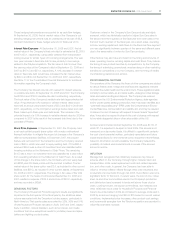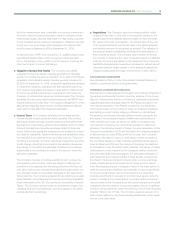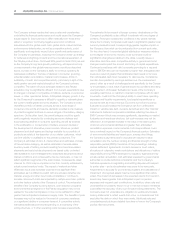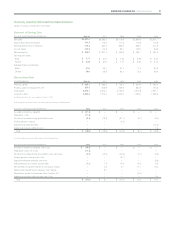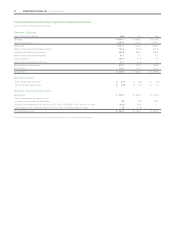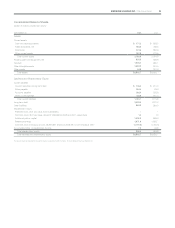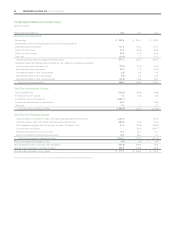Energizer 2008 Annual Report Download - page 20
Download and view the complete annual report
Please find page 20 of the 2008 Energizer annual report below. You can navigate through the pages in the report by either clicking on the pages listed below, or by using the keyword search tool below to find specific information within the annual report.
18 ENERGIZER HOLDINGS, INC. 2008 Annual Report
Management’s Discussion and Analysis of Results of Operations and Financial Condition
(Dollars in millions, except per share and percentage data)
CRITICAL ACCOUNTING POLICIES
The Company identified the policies below as critical to its business
operations and the understanding of its results of operations. The impact
and any associated risks related to these policies on its business
operations is discussed throughout Management’s Discussion and
Analysis of Results of Operations and Financial Condition, where such
policies affect the reported and expected financial results.
Preparation of the financial statements in conformity with generally
accepted accounting principles (GAAP) in the U.S. requires the
Company to make estimates and assumptions that affect the reported
amounts of assets and liabilities, disclosure of contingent assets and
liabilities and the reported amounts of revenues and expenses. On
an ongoing basis, the Company evaluates its estimates, including
those related to customer programs and incentives, product returns,
inventories, intangible assets and other long-lived assets, income
taxes, financing, pensions and other postretirement benefits, and con-
tingencies. Actual results could differ from those estimates. This listing
is not intended to be a comprehensive list of all of the Company’s
accounting policies.
■ Revenue Recognition The Company’s revenue is from the sale
of its products. Revenue is recognized when title, ownership and
risk of loss pass to the customer. When discounts are offered to
customers for early payment, an estimate of such discounts is
recorded as a reduction of net sales in the same period as the sale.
Standard sales terms are final and, except for seasonal sun care
returns which is discussed in detail in the next paragraph, returns
or exchanges are not permitted unless a special exception is made;
reserves are established and recorded in cases where the right of
return does exist for a particular sale.
Under certain circumstances, we allow customers to return Sun
Care products that have not been sold by the end of the sun care
season, which is normal practice in the sun care industry. We record
sales at the time the title, ownership and risk of loss pass to the
customer. The terms of these sales vary but, in all instances, the
following conditions are met: the sales arrangement is evidenced
by purchase orders submitted by customers; the selling price is
fixed or determinable; title to the product has transferred; there
is an obligation to pay at a specified date without any additional
conditions or actions required by the Company; and collectability is
reasonably assured. Simultaneous with the sale, we reduce sales
and cost of sales, and reserve amounts on our consolidated bal-
ance sheet for anticipated returns based upon an estimated return
level, in accordance with GAAP. Customers are required to pay
for the Sun Care product purchased during the season under the
required terms. Due to the seasonal nature of sun care, we offer a
limited extension of terms to certain qualified customers. This limited
extension requires substantial cash payments prior to or during the
sun care season. We generally receive returns of U.S. Sun Care
products from September through January following the summer
sun care season. We estimate the level of sun care returns using a
variety of inputs including historical experience, consumption trends
during the sun care season and inventory positions at key retailers
as the sun care season progresses. We monitor shipment activity
and inventory levels at key retailers during the season in an effort to
gauge potential returns issues. This allows the Company to manage
shipment activity to our customers, especially in the latter stages of
the sun care season, to reduce the potential for returned product.
The level of returns may fluctuate from our estimates due to several
factors including weather conditions, customer inventory levels, and
competitive conditions. Based on our 2008 Sun Care shipments,
each percentage point change in our returns rate would have
impacted our reported net sales by $2.8 and our reported operating
income by $2.3.
The Company offers a variety of programs, primarily to its retail cus-
tomers, designed to promote sales of its products. Such programs
require periodic payments and allowances based on estimated
results of specific programs and are recorded as a reduction to net
sales. The Company accrues, at the time of sale, the estimated
total payments and allowances associated with each transaction.
Additionally, the Company offers programs directly to consumers to
promote the sale of its products. Promotions which reduce the ulti-
mate consumer sale prices are recorded as a reduction of net sales
at the time the promotional offer is made, generally using estimated
redemption and participation levels. Taxes we collect on behalf of
governmental authorities, which are generally included in the price
to the customer, are also recorded as a reduction of net sales.
The Company continually assesses the adequacy of accruals for
customer and consumer promotional program costs not yet paid.
To the extent total program payments differ from estimates, adjust-
ments may be necessary. Historically, these adjustments have not
been material to annual results.
■ Pension Plans and Other Postretirement Benefits The determi-
nation of the Company’s obligation and expense for pension and
other postretirement benefits is dependent on certain assumptions
developed by the Company and used by actuaries in calculating
such amounts. Assumptions include, among others, the discount
rate, future salary increases and the expected long-term rate of
return on plan assets. Actual results that differ from assumptions
made are recognized on the balance sheet and subsequently amor-
tized to earnings over future periods. Significant differences in actual
experience or significant changes in assumptions may materially
affect pension and other postretirement obligations. In determining
the discount rate, the Company uses the yield on high-quality bonds
that coincide with the cash flows of its plans’ estimated payouts.
For the U.S. plans, which represent the Company’s most significant
obligations, the CitiGroup yield curve is used in determining the
discount rates.
Of the assumptions listed above, changes in the expected assets
return have the most significant impact on the Company’s annual
earnings prospectively. A one percentage point decrease or
increase in expected assets return would decrease or increase the
Company’s pre-tax pension expense by approximately $7. In ad-
dition, it may increase and accelerate the rate of required pension
contributions in the future.


